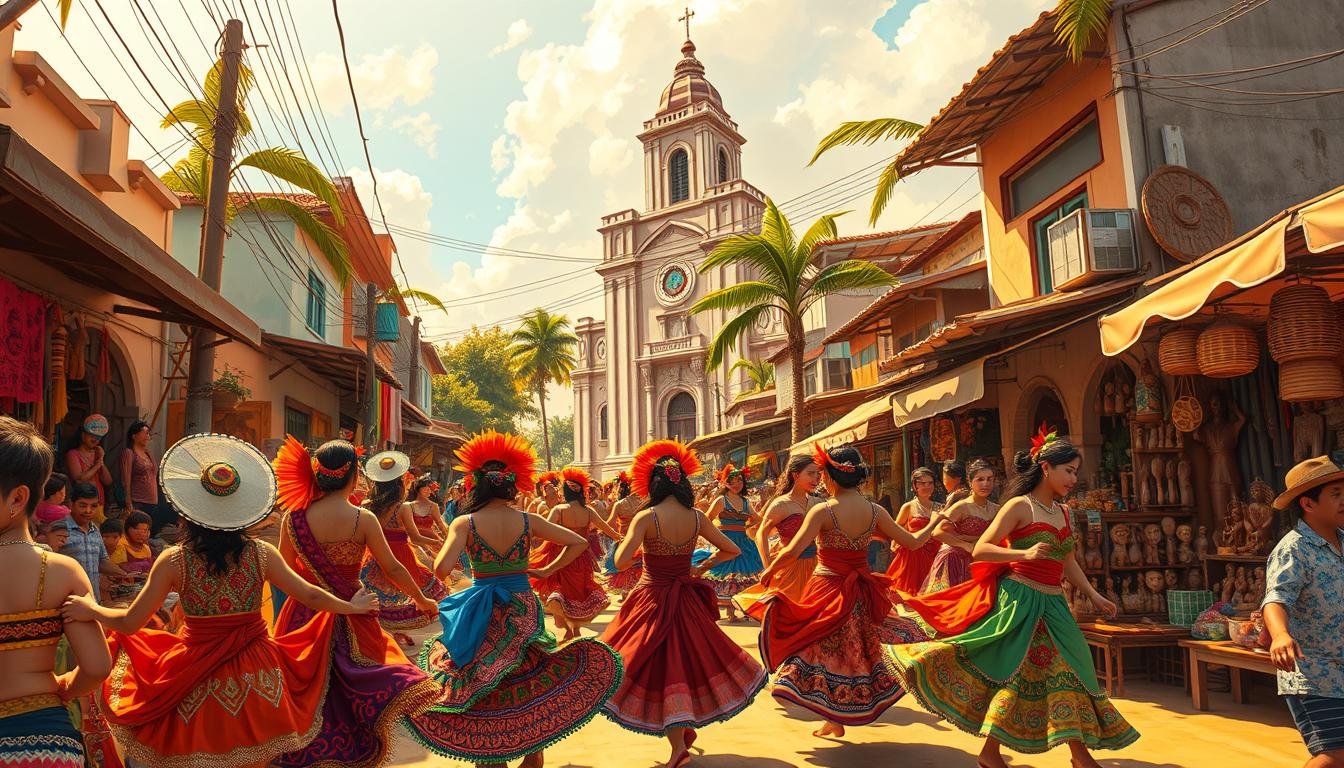Did you know that over 81% of the population in the Philippines identifies as Catholic, a legacy of over 300 years of Spanish rule? This statistic highlights the profound impact of Spanish colonialism on the culture and history of the Philippines. Situated in Asia, this island nation became a melting pot of indigenous practices and European influences, shaping its unique identity.
Before the Spanish arrived, the Philippines had a rich tapestry of local customs and social structures, such as the barangay system. The Spanish colonization introduced new religious, linguistic, and cultural elements, blending with existing traditions. This fusion created a vibrant culture that continues to thrive today.
From festivals to language, the Spanish influence is deeply embedded in the Philippines. This article explores how these elements evolved and became an integral part of the nation’s identity, offering a glimpse into a fascinating chapter of history.
Key Takeaways
- Spanish rule in the Philippines lasted over 300 years, leaving a lasting cultural impact.
- Catholicism became the dominant religion, influencing festivals and daily life.
- Indigenous practices blended with Spanish elements to create a unique culture.
- The Philippines’ strategic location in Asia made it a cultural crossroads.
- Spanish influence is evident in language, cuisine, and social structures.
Pre-Colonial Foundations and Indigenous Influences
Long before Spanish influence, the Philippines had a rich cultural foundation. Early settlements were organized into barangays, small communities led by a chieftain. These groups were built on strong kinship ties, with family playing a central role in daily life.
The barangay system fostered a sense of unity and cooperation. Each community worked together to sustain their way of life, relying on agriculture, fishing, and trade. This early social structure laid the groundwork for the nation’s cultural identity.
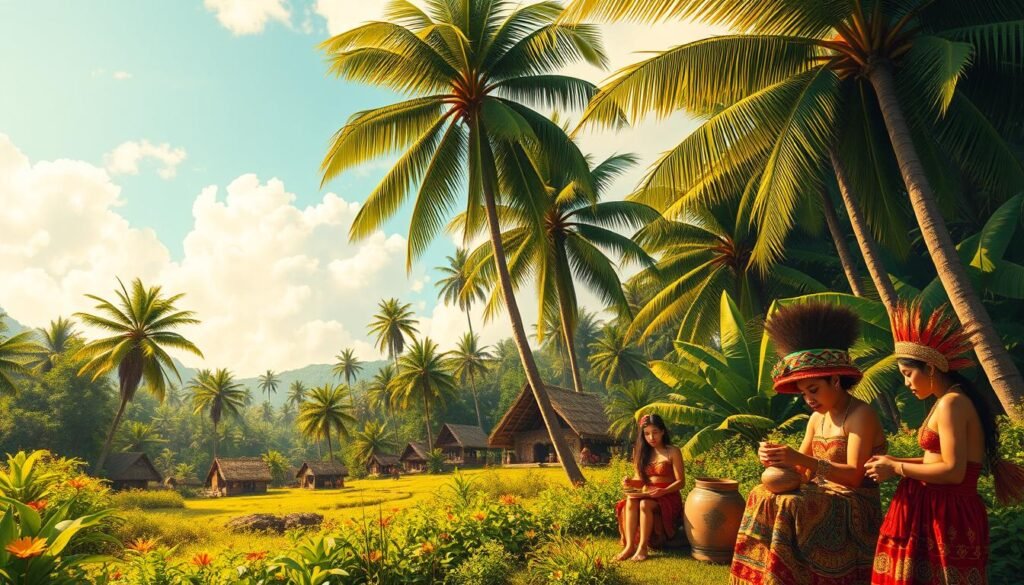
Spiritual beliefs were deeply woven into pre-colonial life. Indigenous rituals honored nature and ancestral spirits. These practices were a vital part of their tradition, shaping their worldview and artistic expressions.
Art forms like pottery, weaving, and carving flourished during this time. These creations were not just decorative but also held cultural and spiritual significance. They reflected the values and history of the group, preserving their legacy for future generations.
Pre-colonial Philippines was a vibrant tapestry of community practices and spiritual rituals. These early foundations would later blend with Spanish influences, creating the unique filipino culture we know today.
Arrival of the Spanish and Cultural Transformation
The arrival of the Spanish in the Philippines marked a turning point in its cultural evolution. Beginning in 1565, Spanish colonization introduced Christianity and European customs, reshaping the archipelago’s social and religious fabric. This period laid the foundation for a unique blend of indigenous and foreign influences.
One of the most significant changes was the spread of Christianity. Missionaries arrived alongside soldiers, converting many to Catholicism. Churches became central to community life, with iconic structures like those in Intramuros, Manila, showcasing Spanish architectural styles. These buildings were not just places of worship but symbols of colonial power and heritage.
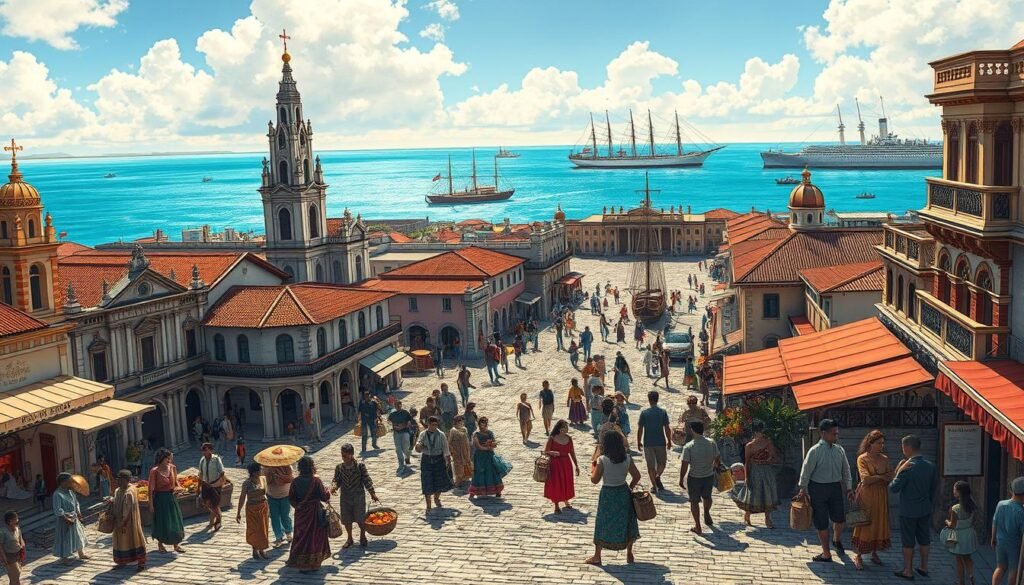
European customs began to permeate daily life. Colonial plazas were designed as gathering spaces, reflecting Spanish urban planning. Traditional practices merged with new rituals, creating a hybrid culture. Manila, as the capital, played a crucial role in integrating these influences, becoming a hub of cultural exchange.
The period also redefined artistic expressions. European art techniques blended with local craftsmanship, resulting in unique styles. This fusion is evident in religious sculptures, paintings, and even music. The Philippines’ history during this time is a testament to its ability to adapt and thrive amidst change.
Introduction of Christianity and European Customs
Christianity became a cornerstone of Filipino identity during the Spanish era. Baptisms and religious festivals became widespread, with the pasyon, a narrative of Jesus’ life, gaining popularity. These practices were deeply intertwined with local customs, creating a distinct religious heritage.
European social structures also took root. The encomienda system organized communities into larger settlements, altering traditional barangay systems. This shift facilitated the spread of Spanish influence, particularly in urban centers like Manila. The integration of European and indigenous elements shaped the Philippines’ cultural landscape, leaving a lasting legacy.
The Transformation from Indigenous Practices to Filipino Folk Traditions
The blending of indigenous practices with Spanish influences created a unique cultural identity in the Philippines. Over time, these elements merged, giving rise to traditions that reflect both local and colonial roots. This transformation was not a replacement but a harmonious integration of old and new.
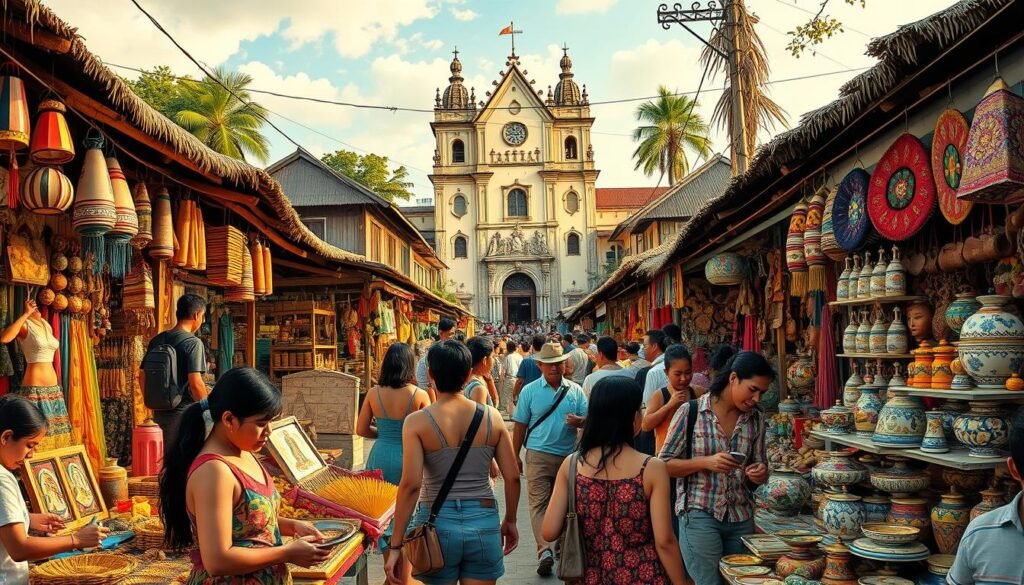
Indigenous rituals and celebrations adapted to include Catholic elements. For example, traditional dance forms like the tinikling evolved, incorporating Spanish music and movements. These adaptations highlight the culture’s ability to absorb and reinterpret foreign influences.
Family customs also underwent changes. Pre-colonial kinship ties remained strong, but Spanish values like religious devotion became a part of daily life. This blend of practices ensured the continuity of indigenous traditions while embracing new ideas.
Cultural Exchange and Adaptation
The colonial period saw a vibrant exchange of artistic expressions. Indigenous craftsmanship merged with European techniques, resulting in unique styles. Religious sculptures and paintings from this era showcase this hybrid tradition.
Festivals like Sinulog and Pahiyas illustrate this cultural fusion. These events combine indigenous rituals with Catholic themes, creating a celebration of shared heritage. Over the century, these traditions have become a defining feature of the Philippine identity.
This process of adaptation highlights the resilience and creativity of the Philippine people. By blending indigenous and colonial elements, they forged a culture that continues to thrive today.
Blending Eastern and Western Artistic Expressions
The fusion of Eastern and Western artistic expressions in the Philippines created a vibrant cultural tapestry. This blending of influences is evident in architecture, music, dance, and literature, showcasing the nation’s ability to harmonize diverse traditions.
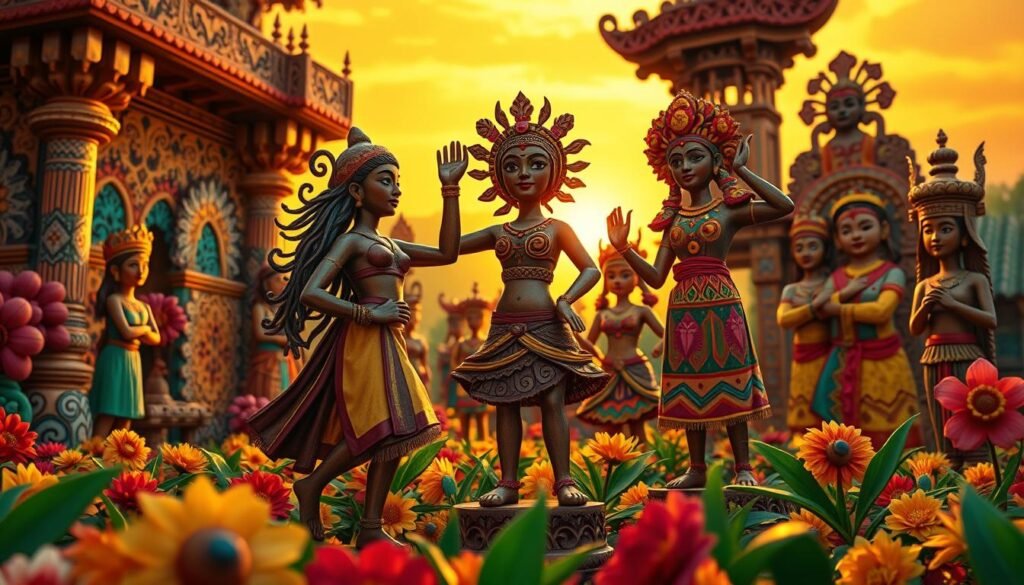
Architectural Heritage
Philippine architecture reflects a unique blend of indigenous techniques and Spanish design. Structures like the Earthquake Baroque churches in Ilocos and Intramuros in Manila showcase this synthesis. These buildings combine local materials with European styles, creating a distinct aesthetic.
The Bahay na Bato, or “stone house,” is another example. It merges traditional Filipino wooden houses with Spanish stone construction, offering both durability and elegance. This architectural style remains a symbol of the nation’s colonial past and cultural resilience.
Music, Dance, and Visual Arts
Music and dance in the Philippines evolved through the integration of local rhythms and European melodies. Traditional dances like the tinikling incorporate Spanish influences, while indigenous instruments blend with Western orchestration.
Visual arts also flourished during this period. Artists like Juan Luna and Felix Resurreccion Hidalgo gained international acclaim, blending European techniques with Filipino themes. Their works highlight the nation’s artistic prowess and cultural identity.
Literary Influences and Narratives
Philippine literature reflects a rich blend of indigenous storytelling and Spanish literary traditions. Works like the Pasyon and Florante at Laura illustrate this fusion, combining local narratives with European poetic forms.
Modern authors continue to explore this synthesis, addressing themes of identity and heritage. Their works contribute to the global recognition of Philippine literature, showcasing its depth and diversity.
“The blending of Eastern and Western artistic expressions has shaped the Philippines into a cultural crossroads, where tradition and innovation coexist harmoniously.”
| Art Form | Eastern Influence | Western Influence |
|---|---|---|
| Architecture | Indigenous materials | Spanish Baroque style |
| Music | Local rhythms | European melodies |
| Literature | Indigenous storytelling | Spanish poetic forms |
The blending of these artistic expressions has left a lasting impact on the Philippine identity. From architecture to literature, the nation’s culture continues to inspire and captivate the world.
For more insights into how colonial influences shaped the Philippines, explore this detailed analysis.
Impact on Daily Life: Family, Festivals, and Community
Spanish colonial rule reshaped the daily lives of people in the Philippines, leaving a lasting impact on family, festivals, and community. The blending of indigenous practices with European customs created a unique way of life that continues to thrive today.
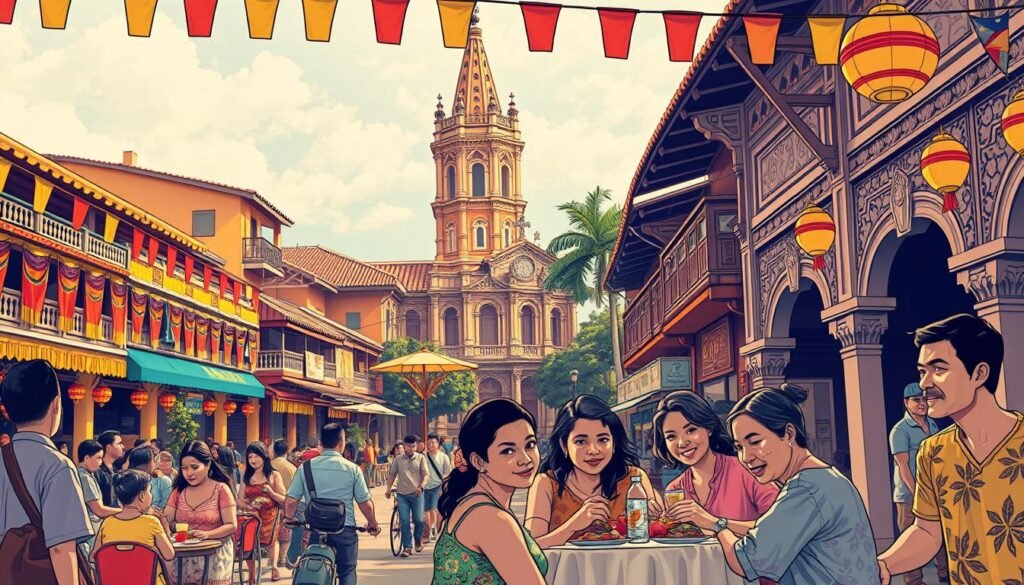
Hospitality and Social Customs
Filipino hospitality is deeply rooted in its community values. The concept of kapamilya, which means extended family, reflects the inclusive nature of social interactions. Neighbors and friends are often treated as part of the family, fostering a close-knit group dynamic.
Communal dining is a hallmark of Filipino gatherings. Sharing meals, whether during a fiesta or a simple family event, strengthens bonds and showcases the importance of food in social life. This tradition highlights the warmth and generosity of the Philippine people.
Celebratory Events and Rituals
Festivals and religious events became central to community life under Spanish influence. Events like Sinulog and Pahiyas blend indigenous rituals with Catholic themes, creating vibrant celebrations that unite the community.
These festivals are not just religious observances but also opportunities for social unity. The bayanihan spirit, or communal effort, is evident in how everyone contributes to the success of these events. This blend of old and new practices has become a defining feature of Philippine culture.
| Aspect | Indigenous Influence | Spanish Influence |
|---|---|---|
| Family Structure | Extended kinship ties | Introduction of nuclear family values |
| Festivals | Nature-based rituals | Religious themes and processions |
| Hospitality | Communal gatherings | Formalized social customs |
The interplay of indigenous and colonial elements has created a unique blend in everyday cultural expressions. From family gatherings to grand festivals, these practices continue to shape the life of the Philippine people. For more insights into Filipino family dynamics, explore this detailed analysis.
Culinary Heritage: Traditional Flavors and Fiesta Foods
Food in the Philippines is more than sustenance; it’s a celebration of identity and community. The country’s culinary heritage reflects centuries of blending indigenous ingredients with Spanish, Asian, and other foreign influences. This fusion has created a unique cuisine that is deeply tied to the nation’s history and culture.
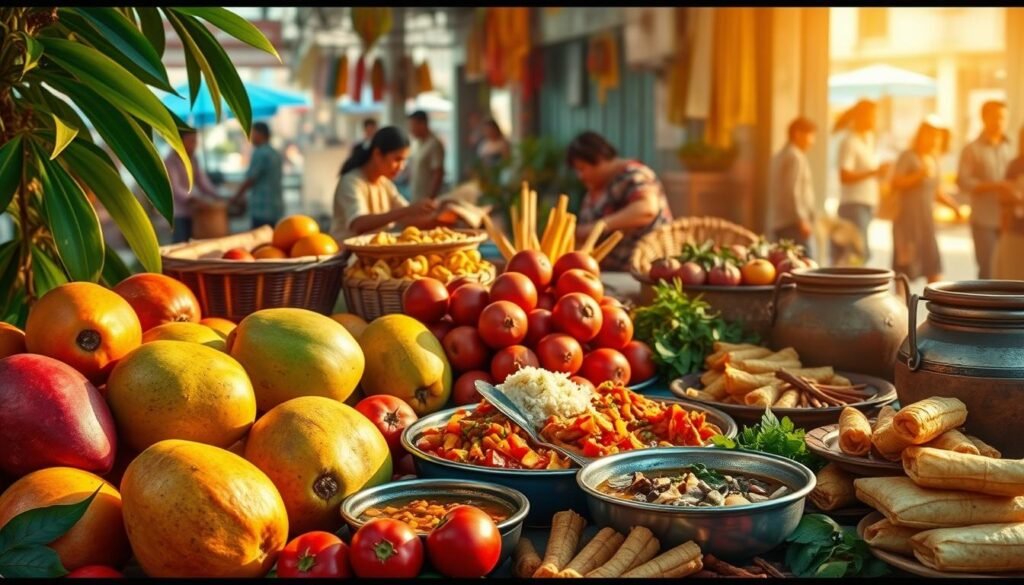
One of the most iconic practices is kamayan, the tradition of eating with the hand. This communal style of dining is often seen during celebrations, symbolizing unity and shared joy. It’s a reminder of the simplicity and authenticity of Filipino culture.
The Role of Food in Cultural Identity
Rice is the cornerstone of every meal, reflecting the country’s agricultural roots. Whether it’s steamed, fried, or paired with savory dishes, rice is a staple that connects people to their heritage. Dishes like adobo, sinigang, and pancit are not just meals but expressions of family traditions passed down through generations.
Fiestas are a vibrant showcase of this culinary identity. Lechon, a whole roasted pig, often takes center stage, symbolizing abundance and communal joy. Other dishes like kare-kare and lumpia highlight the diversity of flavors that define Philippine cuisine.
| Dish | Key Ingredients | Cultural Significance |
|---|---|---|
| Adobo | Soy sauce, vinegar, garlic | National dish, symbolizes resilience |
| Sinigang | Tamarind, pork, vegetables | Represents adaptability and resourcefulness |
| Pancit | Noodles, vegetables, meat | Symbolizes long life and prosperity |
These dishes are more than just food; they are a way to preserve and celebrate the Philippine identity. For a deeper dive into the evolution of Filipino cuisine, explore this detailed analysis.
Preservation and Revival of a Cultural Identity
The Philippines has seen a renewed focus on preserving its cultural identity in recent years. From government policies to grassroots initiatives, efforts to revive and protect the nation’s heritage have gained momentum. These actions aim to ensure that future generations remain connected to their roots while embracing modernity.
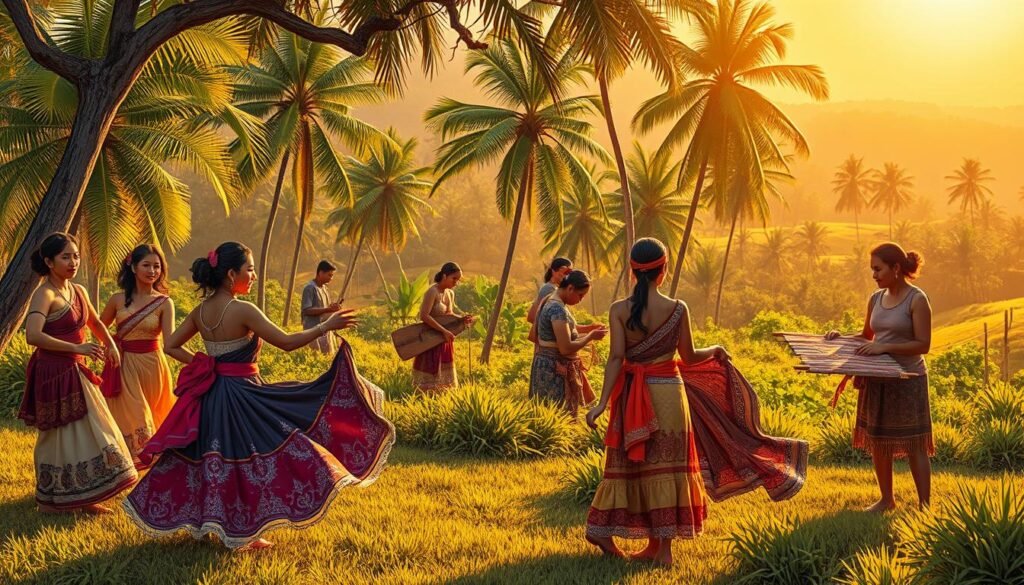
Modern Cultural Policies and Initiatives
Government programs have played a pivotal role in safeguarding the country’s cultural legacy. The National Commission for Culture and the Arts (NCCA) has launched projects to restore historic sites and promote traditional practices. For example, the revival of Baybayin, an ancient script, has been integrated into educational curricula and digital platforms.
Local governments have also stepped up. In Vigan, a UNESCO World Heritage Site, heritage tourism has become a model for balancing preservation with economic growth. Visitors can explore cobblestone streets and ancestral homes, gaining insights into the nation’s colonial past.
Heritage Tourism and Educational Programs
Heritage tourism has emerged as a powerful tool for cultural education. Sites like the Mangyan Cultural Center in Mindoro showcase indigenous traditions, offering workshops and performances. These initiatives not only educate visitors but also empower local communities to sustain their heritage.
Educational programs are equally vital. Schools now incorporate lessons on Philippine history and culture, inspiring students to take pride in their identity. Programs like Baybayin workshops and cultural festivals foster a deeper appreciation for the nation’s rich legacy.
| Initiative | Focus Area | Impact |
|---|---|---|
| Baybayin Revival | Education & Digital Integration | Promotes linguistic heritage |
| Vigan Heritage Tourism | Historic Preservation | Boosts local economy |
| Mangyan Cultural Center | Indigenous Traditions | Empowers local communities |
These efforts highlight the importance of cultural preservation in nation-building. By reviving traditions and educating the younger generation, the Philippines ensures its heritage remains a source of pride and inspiration. For more on these initiatives, explore this detailed analysis.
Influence on Contemporary Filipino Identity
The Philippines’ cultural identity today is a vibrant blend of historical influences and modern innovations. From the bustling streets of Manila to the serene countryside, the nation’s heritage continues to evolve, reflecting a unique fusion of past and present.
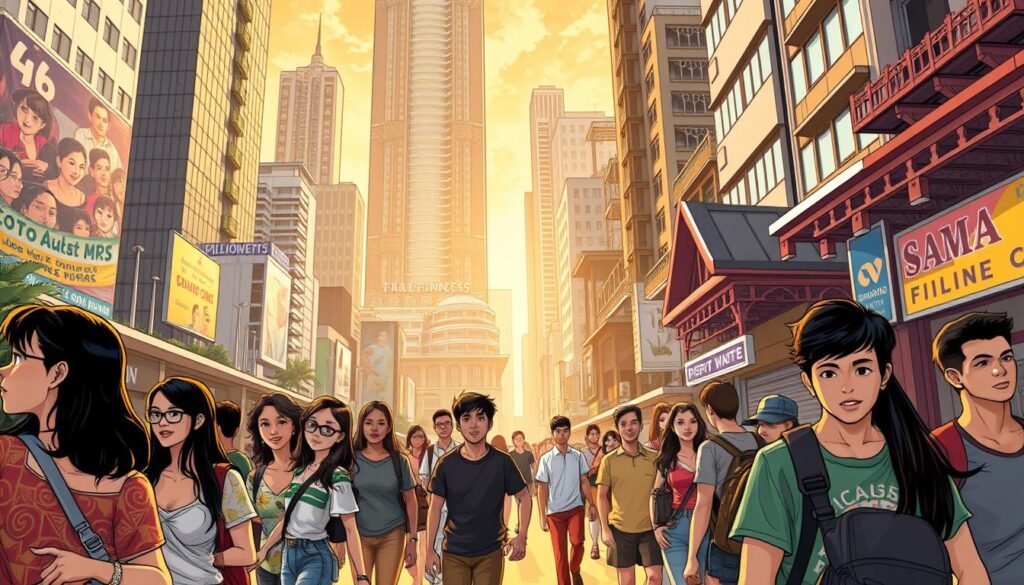
In urban centers like Manila, traditional forms such as dance and music are repurposed in modern settings. Street art and performances often draw inspiration from historical narratives, creating a dynamic cultural landscape. These expressions highlight the adaptability of Filipino culture in a rapidly changing world.
Urban and Rural Cultural Evolutions
While city life embraces modernity, rural regions preserve age-old traditions. Festivals in the countryside often feature indigenous rituals, offering a glimpse into the nation’s rich heritage. This contrast between urban and rural practices underscores the diversity of the Filipino identity.
Personal and collective stories also play a crucial role in shaping this identity. Tales of resilience and community are passed down through generations, fostering a sense of unity. These narratives, rooted in history, continue to inspire modern Filipinos.
Traditional architectural elements are visible in modern city designs. Structures like the Bahay na Bato blend colonial and indigenous styles, serving as reminders of the nation’s past. This integration of old and new reflects the enduring influence of history on contemporary life.
Understanding regional variations is key to appreciating the broader national narrative. Each region contributes unique cultural expressions, enriching the collective identity. From the northern islands to the southern regions, the Philippines’ cultural tapestry is as diverse as its geography.
For more insights into how religion shapes Filipino identity, explore this detailed analysis.
Conclusion
The journey of the Philippines’ cultural evolution is a testament to its resilience and adaptability. From pre-colonial history to the profound impact of Spanish rule, the nation has woven a rich tapestry of influences. This blend of Eastern and Western elements is evident in its art, music, and social customs, creating a unique identity that continues to thrive.
Celebrations like Christmas and other major holidays showcase the enduring spirit of the people. Urban centers and rural regions alike reflect centuries of cultural evolution, with festivals and dance preserving heritage while inspiring future generations. These events are more than just gatherings; they are a celebration of shared history and identity.
As the Philippines navigates the modern world, the importance of cultural preservation remains vital. By honoring its past, the nation ensures that its vibrant traditions continue to shape its life and inspire the world. For a deeper understanding of this cultural journey, explore this detailed analysis.
FAQ
How did Spanish colonization shape local customs in the Philippines?
The Spanish introduced Christianity, European customs, and governance, which blended with indigenous practices to create unique cultural expressions still seen today.
What role did food play in preserving cultural identity?
Traditional dishes and fiesta meals became symbols of heritage, reflecting the fusion of indigenous ingredients and Spanish culinary techniques.
How did pre-colonial spiritual beliefs influence modern rituals?
Indigenous rituals and spiritual practices laid the foundation for many contemporary celebrations, blending with Christian traditions introduced by the Spanish.
What are some examples of blended artistic expressions?
Architecture, music, dance, and visual arts showcase a mix of Eastern and Western influences, creating a distinct cultural identity.
How are modern efforts preserving cultural heritage?
Initiatives like heritage tourism, educational programs, and cultural policies aim to revive and sustain traditional practices for future generations.
What is the significance of festivals in community life?
Festivals, or fiestas, serve as vibrant celebrations of history, faith, and community, often featuring music, dance, and traditional foods.
How has urbanization affected cultural traditions?
While urban areas have seen rapid modernization, rural regions often retain traditional practices, creating a dynamic cultural evolution across the country.
What is the importance of family in shaping cultural identity?
Family remains central to social customs, passing down traditions, values, and practices from one generation to the next.
Source Links
- Spanish influence on Filipino culture
- The Spanish Influence on Filipino Culture and Language
- Spanish Colonial Influences on Filipino Culture
- Cultural achievements of pre-colonial Philippines
- Indigenous Peoples in the Philippines: Continuing Struggle
- Folk Traditions – National Commission for Culture and the Arts
- The Philippines at the Turn of the Sixteenth Century. Christianity
- Culture of the Philippines
- From Tradition to Identity: Exploring the Cultural Heritage of the Philippines
- Contemporary Arts in the Philippines: An Introduction
- The Bayanihan Delights Audiences with Rich Diversity of Filipino Culture
- The Philippines: Culture and Tradition – Globalization Partners International
- Philippines – Culture, Diversity, Traditions | Britannica
- Family Ties: The Heartbeat of Filipino Culture
- Philippine Culture: Learning About Traditions and Customs | Asterra
- Discover the Best Filipino Fiesta Foods: Celebrations and Feasts
- Filipino Cuisine: An Underrated Culinary Gem
- Detailed Guide to Local Cuisine of the Philippines: Traditional Filipino Food & Delicacies | Guide to the Philippines
- The Importance of Reviving Baybayin in Education | Asterra
- Preserving Heritage: The Mangyan Cultural Center in the Philippines – Filipina Architect Magazine
- From Indigenous Roots to Global Fusion: The Evolution of Filipino Culture and Its Impact on Today’s Workforce
- Filipino – Core Concepts
- Philippine folk literature
- Understanding Folk Religiosity in the Philippines
- Philippine Folklore and Mythology – Festive Pinoy

